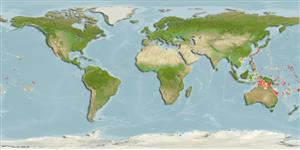Classificação / Names
Nomes comuns | Sinônimos | Catalog of Fishes(Gênero, Espécies) | ITIS | CoL | WoRMS | Cloffa
>
Ovalentaria/misc (Various families in series Ovalentaria) >
Pomacentridae (Damselfishes) > Pomacentrinae
Etymology: Pomacentrus: Greek, poma, -atos = cover, operculum + Greek, kentron = sting (Ref. 45335); bipunctatus: Named Pomacentrus bipunctatus as reference to pair of dark spots on the upper operculum and upper pectoral fin base which is its most distinctive marking and a feature lacking in other pomacentrids from the Marshall and eastern Caroline Islands.
More on authors: Allen & Randall.
Environment: milieu / climate zone / depth range / distribution range
Ecologia
marinhas associadas(os) a recifes; não migratória; intervalo de profundidade 5 - 43 m (Ref. 54758). Tropical
Central Pacific: Known from the Marshall Islands at Enewetak and Kwajalein atolls, and also from Truk in the eastern Caroline Islands.
Tamanho / Peso / Idade
Maturity: Lm ? range ? - ? cm
Max length : 5.5 cm SL macho/indeterminado; (Ref. 54758)
This species occurs in lagoonal habitats on coral reef substrates, often on pinnacle or patch reefs at depths between 5 and 43 m (Ref. 54758). Life history characteristics for the family specify that this group is oviparous, with distinct pairing during breeding (Ref. 205). Eggs are demersal and adhere to the substrate (Ref. 205). Males guard and aerate the eggs (Ref. 205).
Ciclo de vida ou comportamento de acasalamento
Maturidade | Reprodução | Desova | Ovos | Fecundidade | Larvas
Life history characteristics for the family specify that this group is oviparous, with distinct pairing during breeding (Ref. 205). Eggs are demersal and adhere to the substrate (Ref. 205). Males guard and aerate the eggs (Ref. 205).
Allen, G.R. and J.E. Randall, 2004. Two new species of damselfishes (Pomacentridae) from Micronesia. aqua, J. Ichthyol. Aquat. Biol. 9(2):75-87. (Ref. 54758)
Status na Lista Vermelha da UICN (Ref. 130435: Version 2024-2)
Ameaça para os humanos
Harmless
Uso pelos humanos
Ferramentas
Relatórios especiais
Baixar XML
Fontes da internet
Estimates based on models
Preferred temperature (Ref.
123201): 28.3 - 29.1, mean 28.5 °C (based on 12 cells).
Índice de diversidade filogenética (Ref.
82804): PD
50 = 0.5000 [Uniqueness, from 0.5 = low to 2.0 = high].
Bayesian length-weight: a=0.02455 (0.01155 - 0.05216), b=2.98 (2.81 - 3.15), in cm total length, based on LWR estimates for this Genus-body shape (Ref.
93245).
Nível Trófico (Ref.
69278): 2.7 ±0.3 se; based on size and trophs of closest relatives
Resiliência (Ref.
120179): Elevada, tempo mínimo de duplicação da população menor que 15 meses (Preliminary K or Fecundity.).
Fishing Vulnerability (Ref.
59153): Low vulnerability (10 of 100).
